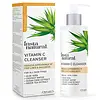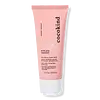What's inside
What's inside
 Key Ingredients
Key Ingredients

 Benefits
Benefits

 Concerns
Concerns

 Ingredients Side-by-side
Ingredients Side-by-side

Water
Skin ConditioningCocamidopropyl Hydroxysultaine
CleansingDecyl Glucoside
CleansingGlycerin
HumectantPropanediol
SolventShea Butteramidopropyl Betaine
CleansingSodium Methyl Cocoyl Taurate
CleansingDisodium Laureth Sulfosuccinate
CleansingSodium Lauryl Sulfoacetate
CleansingSodium Ascorbyl Phosphate
AntioxidantCoco-Glucoside
CleansingGlyceryl Oleate
EmollientTetrasodium Glutamate Diacetate
Hydrolyzed Jojoba Esters
Skin ConditioningLactic Acid
BufferingSaccharum Officinarum Extract
MoisturisingCamellia Sinensis Leaf Extract
AntimicrobialCitrus Grandis Peel Oil
MaskingCocos Nucifera Oil
MaskingAloe Barbadensis Leaf Extract
EmollientLimnanthes Alba Seed Oil
Skin ConditioningGlucosyl Hesperidin
HumectantRosmarinus Officinalis Leaf Extract
AntimicrobialCentella Asiatica Extract
CleansingHibiscus Rosa-Sinensis Flower Extract
HumectantRosa Centifolia Flower Extract
AstringentCucumis Sativus Fruit Extract
EmollientChamomilla Recutita Flower Extract
MaskingCocos Nucifera Fruit Juice
EmollientSalix Alba Bark Extract
AstringentXanthan Gum
EmulsifyingSclerotium Gum
Emulsion StabilisingHydroxyacetophenone
AntioxidantPhenethyl Alcohol
MaskingPentylene Glycol
Skin ConditioningLimonene
PerfumingWater, Cocamidopropyl Hydroxysultaine, Decyl Glucoside, Glycerin, Propanediol, Shea Butteramidopropyl Betaine, Sodium Methyl Cocoyl Taurate, Disodium Laureth Sulfosuccinate, Sodium Lauryl Sulfoacetate, Sodium Ascorbyl Phosphate, Coco-Glucoside, Glyceryl Oleate, Tetrasodium Glutamate Diacetate, Hydrolyzed Jojoba Esters, Lactic Acid, Saccharum Officinarum Extract, Camellia Sinensis Leaf Extract, Citrus Grandis Peel Oil, Cocos Nucifera Oil, Aloe Barbadensis Leaf Extract, Limnanthes Alba Seed Oil, Glucosyl Hesperidin, Rosmarinus Officinalis Leaf Extract, Centella Asiatica Extract, Hibiscus Rosa-Sinensis Flower Extract, Rosa Centifolia Flower Extract, Cucumis Sativus Fruit Extract, Chamomilla Recutita Flower Extract, Cocos Nucifera Fruit Juice, Salix Alba Bark Extract, Xanthan Gum, Sclerotium Gum, Hydroxyacetophenone, Phenethyl Alcohol, Pentylene Glycol, Limonene
Water
Skin ConditioningGlycerin
HumectantBetaine
HumectantMusa Sapientum Fruit Extract
Skin ConditioningSaccharomyces Ferment
Skin ConditioningCapryl/Capramidopropyl Betaine
CleansingArginine
MaskingXanthan Gum
EmulsifyingPolyglyceryl-6 Caprylate
EmulsifyingPolyglyceryl-4 Caprate
EmulsifyingPolyglyceryl-4 Cocoate
EmollientPolyglyceryl-6 Ricinoleate
EmulsifyingHibiscus Sabdariffa Flower Extract
Skin ConditioningIsoamyl Laurate
EmollientSodium Chloride
MaskingVitis Vinifera Fruit Extract
Skin ConditioningSodium Hyaluronate
HumectantLactic Acid
BufferingPhenylpropanol
MaskingCitric Acid
BufferingTartaric Acid
BufferingGluconic Acid
Water, Glycerin, Betaine, Musa Sapientum Fruit Extract, Saccharomyces Ferment, Capryl/Capramidopropyl Betaine, Arginine, Xanthan Gum, Polyglyceryl-6 Caprylate, Polyglyceryl-4 Caprate, Polyglyceryl-4 Cocoate, Polyglyceryl-6 Ricinoleate, Hibiscus Sabdariffa Flower Extract, Isoamyl Laurate, Sodium Chloride, Vitis Vinifera Fruit Extract, Sodium Hyaluronate, Lactic Acid, Phenylpropanol, Citric Acid, Tartaric Acid, Gluconic Acid
Ingredients Explained
These ingredients are found in both products.
Ingredients higher up in an ingredient list are typically present in a larger amount.
Glycerin is already naturally found in your skin. It helps moisturize and protect your skin.
A study from 2016 found glycerin to be more effective as a humectant than AHAs and hyaluronic acid.
As a humectant, it helps the skin stay hydrated by pulling moisture to your skin. The low molecular weight of glycerin allows it to pull moisture into the deeper layers of your skin.
Hydrated skin improves your skin barrier; Your skin barrier helps protect against irritants and bacteria.
Glycerin has also been found to have antimicrobial and antiviral properties. Due to these properties, glycerin is often used in wound and burn treatments.
In cosmetics, glycerin is usually derived from plants such as soybean or palm. However, it can also be sourced from animals, such as tallow or animal fat.
This ingredient is organic, colorless, odorless, and non-toxic.
Glycerin is the name for this ingredient in American English. British English uses Glycerol/Glycerine.
Learn more about GlycerinLactic Acid is another well-loved alpha hydroxy acid (AHA). It is gentler than glycolic acid but still highly effective.
Its main role is to exfoliate the surface of the skin by loosening the “glue” that holds dead skin cells together. Shedding those old cells leads to smoother, softer, and more even-toned skin.
Because lactic acid molecules are larger than glycolic acid, they don’t penetrate as deeply. This means they’re less likely to sting or irritate, making it a great choice for beginners or those with sensitive skin.
Like glycolic acid, it can:
Lactic acid also acts as a humectant (like hyaluronic acid). It can draw water into the skin to improve hydration and also plays a role in the skin's natural moisturizing factor (NMF) in the form of sodium lactate.
Studies show it can boost ceramide production to strengthen the skin barrier and even help balance the skin’s microbiome.
To get results, choose products with a pH between 3-4.
Lower strengths (5-12%) focus on surface exfoliation; higher strengths (12% and up) can reach deeper in the dermis (deeper, supportive layer) to improve skin texture and firmness over time.
Though it was originally derived from milk, most modern lactic acid used in skincare is vegan. It is made through non-dairy fermentation to create a bio-identical and stable form suitable for all formulations.
When lactic acid shows up near the end of an ingredient list, it usually means the brand added just a tiny amount to adjust the product’s pH.
Legend has it that Cleopatra used to bathe in sour milk to help reduce wrinkles.
Lactic acid is truly a gentle multitasker: it exfoliates, hydrates, strengthens, and brightens. It's a great ingredient for giving your skin a smooth, glowing, and healthy look without the harshness of stronger acids.
Read more about some other popular AHA's here:
Learn more about Lactic AcidWater. It's the most common cosmetic ingredient of all. You'll usually see it at the top of ingredient lists, meaning that it makes up the largest part of the product.
So why is it so popular? Water most often acts as a solvent - this means that it helps dissolve other ingredients into the formulation.
You'll also recognize water as that liquid we all need to stay alive. If you see this, drink a glass of water. Stay hydrated!
Learn more about WaterXanthan gum is used as a stabilizer and thickener within cosmetic products. It helps give products a sticky, thick feeling - preventing them from being too runny.
On the technical side of things, xanthan gum is a polysaccharide - a combination consisting of multiple sugar molecules bonded together.
Xanthan gum is a pretty common and great ingredient. It is a natural, non-toxic, non-irritating ingredient that is also commonly used in food products.
Learn more about Xanthan Gum